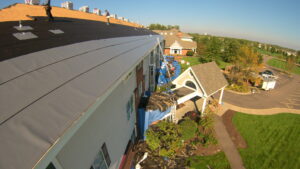
When it comes to reconstructing a roof in Little Rock AR, there are various types of roofing systems to choose from depending on your budget, location, and desired aesthetics. Each roofing system has its unique features, advantages, and disadvantages.
- Asphalt Shingles: Asphalt shingles are the most popular type of roofing system in North America due to their affordability, durability, and ease of installation. They are made of fiberglass or organic materials that are coated with asphalt and mineral granules for added protection against UV rays and weathering. Asphalt shingles come in a wide range of styles, colors, and textures, making them suitable for various architectural styles. However, they may have a shorter lifespan compared to other roofing systems, typically lasting around 15 to 30 years.
- Metal Roofing: Metal roofing systems are known for their longevity and durability. They are available in various types of metals, such as steel, aluminum, copper, and zinc, and offer excellent resistance against fire, wind, and hail. Metal roofs can last for 50 years or more with proper maintenance and are also energy-efficient as they reflect heat, helping to reduce energy consumption. Metal roofs can be installed in different styles, such as standing seam, corrugated, and metal shingles, providing versatility in design options. However, metal roofing systems can be more expensive than other types of roofs and may require professional restoration company installation due to their unique installation methods.
- Wood Shakes or Shingles: Wood shakes or shingles are a popular choice for homeowners who prefer a natural and rustic look for their roofs. They are typically made from cedar, redwood, or other types of hardwood and are known for their unique grain patterns and warm appearance. Wood shakes or shingles can last for 30 to 50 years when properly maintained and offer good insulation properties. However, they require regular maintenance, such as sealing and staining, to prevent decay, insect infestation, and fire hazards. Wood shakes or shingles are also more expensive than other roofing systems and may not be suitable for areas prone to wildfires or high humidity.
- Tile Roofing: Tile roofing systems are known for their durability and aesthetics, making them a popular choice for Mediterranean, Spanish, and Southwestern architectural styles. They can be made from clay, concrete, or slate and offer excellent resistance against fire, insects, and rot. Tile roofs are available in various shapes, such as flat, curved, and interlocking, and come in different colors and textures. They have a long lifespan of 50 to 100 years and are known for their low maintenance requirements. However, tile roofs can be heavy and may require additional structural support, making them more expensive to install. They are also fragile and can break under heavy impact, requiring careful handling during installation and maintenance.
- Synthetic Roofing: Synthetic roofing systems are gaining popularity due to their durability, affordability, and versatility. They are made from synthetic materials, such as rubber, plastic, or composite, and can mimic the appearance of other types of roofs, such as wood shakes, slate, or tile. Synthetic roofs are lightweight, easy to install, and offer good resistance against weathering, UV rays, and pests. They are also low maintenance and can last for 30 to 50 years. However, synthetic roofs may not have the same authentic look and feel as natural materials, and their lifespan may not be as long as some other types of roofs.
In conclusion, there are several types of roofing systems to choose from when it comes to reconstructing your roof. Each type has its unique features, advantages, and disadvantages, and it’s essential to consider factors such as budget, and location.
Service Pro Restoration
900 S Shackleford Rd Little Rock AR, 72211
501-273-3030
